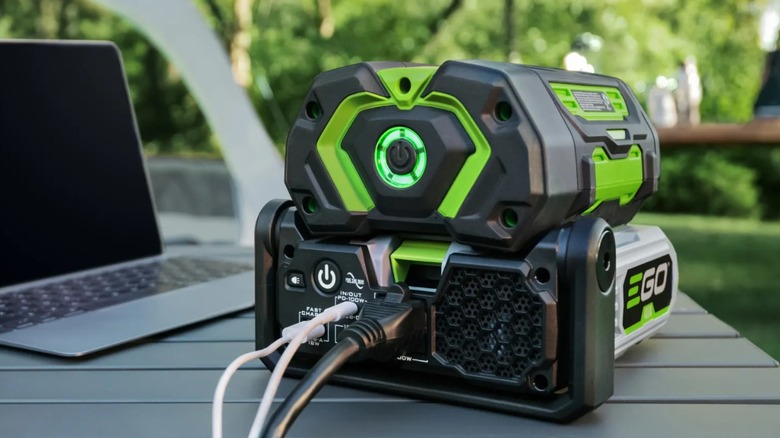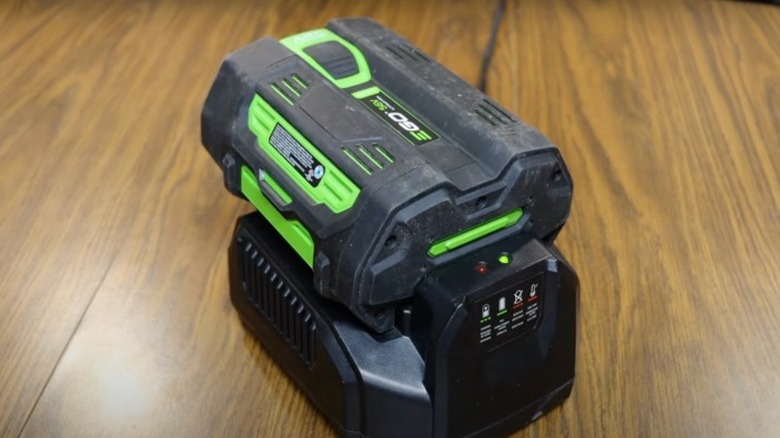How Long Do Ego Batteries Typically Last And Can They Be Left On The Charger?
Chervon's Ego tools have become quite popular in the last few years, with its newest lawn care and power tools boasting gas-like performance with the help of its proprietary battery packs. These packs are loaded with advanced technologies that differentiate them from batteries offered by other hardware brands, as well as convenient features like an elaborate notification light. Of course, no matter how fancy these battery packs are, they are still batteries and are as finite as anything else designed to store and deliver energy.
Ego batteries, to their credit, are very hearty, with even the smallest-capacity battery having a minimum shelf of well over a decade. However, that shelf life is heavily contingent on how you treat the battery, including its stated charge capacity, where and how you store it, and whether you follow proper storage procedures. One particularly important rule you need to be aware of is taking the battery out of its charging cradle if you're going to be storing it long-term. So long as you take proper care of your Ego batteries, they'll provide all the power your Ego tools need for a long time.
Ego batteries have a minimum shelf life of around 12 years
All rechargeable batteries are designed to be reused but that design always comes with an asterisk. No matter how tough a battery pack is, constantly storing and discharging electricity will gradually wear down its contacts and internal components, hampering its ability to hold a charge. This is why all battery packs will invariably fail eventually.
Ego battery packs, for their part, are built pretty tough. According to an official battery FAQ document from Ego, all Ego battery packs have a baseline shelf life of about 12 years, assuming proper storage and care. The brand's smallest 2.5 Ah battery pack will last about that long, while higher-capacity battery packs are rated to last progressively longer. For example, the brand's highest-capacity 12 Ah battery pack is supposed to be good for up to 23 years in unattended storage before its charge/discharge efficacy starts to drop off.
It is worth noting that, based on user testimony from social platforms like Reddit, the actual length of your Ego battery's lifespan can vary. Proper care, particularly even-temperature storage, will frequently keep them healthy, but some users report sudden failure after as few as three years. On the bright side, most domestic-use Ego batteries come with a three-year manufacturer warranty if you register the product (two years if you don't), so if it fails in that timeframe, you should be able to get a replacement.
How long an Ego battery can stay on its charger
A common move power tool owners make is leaving their rechargeable battery packs on their chargers whenever they're not in use. It makes sense on paper; you want your battery to be charged up, so it's ready to use. Batteries from most hardware brands like Milwaukee are shored up against overcharging but leaving them on the hook for too long is still bad for them.
For Ego batteries, the brand's FAQ states that it is safe to leave them in the charging cradle while they're not in use but only for a maximum of 30 days. This is because all Ego battery packs are built with a special discharging feature — when 30 days elapse, the batteries automatically discharge whatever energy they have stored until they reach their default storing capacity of 30%.
Basically, if you're using your Ego battery in a tool on a fairly regular basis, it's okay to leave it in the charger whenever it's not in use. It's ideal to remove the battery from the charger when it's done charging, but it's not the end of the world if you don't. On the other hand, if you know for sure that you're not going to need that particular battery for a while, especially if it's longer than 30 days, you should keep the battery off its charger and store it in a dry, even-temperature location.


